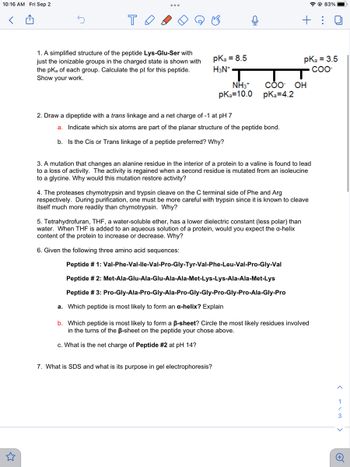
Biochemistry
9th Edition
ISBN: 9781319114671
Author: Lubert Stryer, Jeremy M. Berg, John L. Tymoczko, Gregory J. Gatto Jr.
Publisher: W. H. Freeman
expand_more
expand_more
format_list_bulleted
Question
3

Transcribed Image Text:10:16 AM Fri Sep 2
<
то
1. A simplified structure of the peptide Lys-Glu-Ser with
just the ionizable groups in the charged state is shown with
the pKa of each group. Calculate the pl for this peptide.
Show your work.
pka = 8.5
H3N+
NH3*
pKa 10.0
2. Draw a dipeptide with a trans linkage and a net charge of -1 at pH 7
a. Indicate which six atoms are part of the planar structure of the peptide bond.
b. Is the Cis or Trans linkage of a peptide preferred? Why?
COO- OH
pka=4.2
3. A mutation that changes an alanine residue in the interior of a protein to a valine is found to lead
to a loss of activity. The activity is regained when a second residue is mutated from an isoleucine
to a glycine. Why would this mutation restore activity?
5. Tetrahydrofuran, THF, a water-soluble ether, has a lower dielectric constant (less polar) than
water. When THF is added to an aqueous solution of a protein, would you expect the a-helix
content of the protein to increase or decrease. Why?
6. Given the following three amino acid sequences:
7. What is SDS and what is its purpose in gel electrophoresis?
+:
4. The proteases chymotrypsin and trypsin cleave on the C terminal side of Phe and Arg
respectively. During purification, one must be more careful with trypsin since it is known to cleave
itself much more readily than chymotrypsin. Why?
Peptide # 1: Val-Phe-Val-lle-Val-Pro-Gly-Tyr-Val-Phe-Leu-Val-Pro-Gly-Val
Peptide # 2: Met-Ala-Glu-Ala-Glu-Ala-Ala-Met-Lys-Lys-Ala-Ala-Met-Lys
Peptide # 3: Pro-Gly-Ala-Pro-Gly-Ala-Pro-Gly-Gly-Pro-Gly-Pro-Ala-Gly-Pro
a. Which peptide is most likely to form an a-helix? Explain
pka = 3.5
COO-
@83%
b. Which peptide is most likely to form a ß-sheet? Circle the most likely residues involved
in the turns of the ß-sheet on the peptide your chose above.
c. What is the net charge of Peptide #2 at pH 14?
(113
+
Expert Solution
This question has been solved!
Explore an expertly crafted, step-by-step solution for a thorough understanding of key concepts.
This is a popular solution
Trending nowThis is a popular solution!
Step by stepSolved in 3 steps

Knowledge Booster
Similar questions
- What is the P Wave in the strip? Sinus Intermittently present Multiform Irregular uarrow_forward(99+arrow_forwardKEY: Hydrophobic interactions: Salt bridge: Covalent bonds: Hydrogen bonding: Metal ion coordination: 9. 10What components of the plasma membrane might you drug interact with? Explain can use as many components as you need (may need more or less). Component 1 and why: Component 2 and why: Component 3 and why:arrow_forward
arrow_back_ios
arrow_forward_ios
Recommended textbooks for you
 BiochemistryBiochemistryISBN:9781319114671Author:Lubert Stryer, Jeremy M. Berg, John L. Tymoczko, Gregory J. Gatto Jr.Publisher:W. H. Freeman
BiochemistryBiochemistryISBN:9781319114671Author:Lubert Stryer, Jeremy M. Berg, John L. Tymoczko, Gregory J. Gatto Jr.Publisher:W. H. Freeman Lehninger Principles of BiochemistryBiochemistryISBN:9781464126116Author:David L. Nelson, Michael M. CoxPublisher:W. H. Freeman
Lehninger Principles of BiochemistryBiochemistryISBN:9781464126116Author:David L. Nelson, Michael M. CoxPublisher:W. H. Freeman Fundamentals of Biochemistry: Life at the Molecul...BiochemistryISBN:9781118918401Author:Donald Voet, Judith G. Voet, Charlotte W. PrattPublisher:WILEY
Fundamentals of Biochemistry: Life at the Molecul...BiochemistryISBN:9781118918401Author:Donald Voet, Judith G. Voet, Charlotte W. PrattPublisher:WILEY BiochemistryBiochemistryISBN:9781305961135Author:Mary K. Campbell, Shawn O. Farrell, Owen M. McDougalPublisher:Cengage Learning
BiochemistryBiochemistryISBN:9781305961135Author:Mary K. Campbell, Shawn O. Farrell, Owen M. McDougalPublisher:Cengage Learning BiochemistryBiochemistryISBN:9781305577206Author:Reginald H. Garrett, Charles M. GrishamPublisher:Cengage Learning
BiochemistryBiochemistryISBN:9781305577206Author:Reginald H. Garrett, Charles M. GrishamPublisher:Cengage Learning Fundamentals of General, Organic, and Biological ...BiochemistryISBN:9780134015187Author:John E. McMurry, David S. Ballantine, Carl A. Hoeger, Virginia E. PetersonPublisher:PEARSON
Fundamentals of General, Organic, and Biological ...BiochemistryISBN:9780134015187Author:John E. McMurry, David S. Ballantine, Carl A. Hoeger, Virginia E. PetersonPublisher:PEARSON

Biochemistry
Biochemistry
ISBN:9781319114671
Author:Lubert Stryer, Jeremy M. Berg, John L. Tymoczko, Gregory J. Gatto Jr.
Publisher:W. H. Freeman

Lehninger Principles of Biochemistry
Biochemistry
ISBN:9781464126116
Author:David L. Nelson, Michael M. Cox
Publisher:W. H. Freeman

Fundamentals of Biochemistry: Life at the Molecul...
Biochemistry
ISBN:9781118918401
Author:Donald Voet, Judith G. Voet, Charlotte W. Pratt
Publisher:WILEY

Biochemistry
Biochemistry
ISBN:9781305961135
Author:Mary K. Campbell, Shawn O. Farrell, Owen M. McDougal
Publisher:Cengage Learning

Biochemistry
Biochemistry
ISBN:9781305577206
Author:Reginald H. Garrett, Charles M. Grisham
Publisher:Cengage Learning

Fundamentals of General, Organic, and Biological ...
Biochemistry
ISBN:9780134015187
Author:John E. McMurry, David S. Ballantine, Carl A. Hoeger, Virginia E. Peterson
Publisher:PEARSON